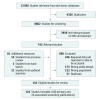All-Cause and Cause-Specific Mortality Among People Using Extramedical Opioids: A Systematic Review and Meta-analysis
- PMID: 31876906
- PMCID: PMC6990804
- DOI: 10.1001/jamapsychiatry.2019.4170
All-Cause and Cause-Specific Mortality Among People Using Extramedical Opioids: A Systematic Review and Meta-analysis
Abstract
Importance: Extramedical opioid use has escalated in recent years. A better understanding of cause-specific mortality in this population is needed to inform comprehensive responses.
Objective: To estimate all-cause and cause-specific crude mortality rates (CMRs) and standardized mortality ratios (SMRs) among people using extramedical opioids, including age- and sex-specific estimates when possible.
Data sources: For this systematic review and meta-analysis, MEDLINE, PsycINFO, and Embase were searched for studies published from January 1, 2009, to October 3, 2019, and an earlier systematic review on this topic published in 2011.
Study selection: Cohort studies of people using extramedical opioids and reporting mortality outcomes were screened for inclusion independently by 2 team members.
Data extraction and synthesis: Data were extracted by a team member and checked by another team member. Study quality was assessed using a custom set of items that examined risk of bias and quality of reporting. Data were pooled using random-effects meta-analysis models. Heterogeneity was assessed using stratified meta-analyses and meta-regression.
Main outcomes and measures: Outcome measures were all-cause and cause-specific CMRs and SMRs among people using extramedical opioids compared with the general population of the same age and sex.
Results: Of 8683 identified studies, 124 were included in this analysis (100 primary studies and 24 studies providing additional data for primary studies). The pooled all-cause CMR, based on 99 cohorts of 1 262 592 people, was 1.6 per 100 person-years (95% CI, 1.4-1.8 per 100 person-years), with substantial heterogeneity (I2 = 99.7%). Heterogeneity was associated with the proportion of the study sample that injected opioids or was living with HIV infection or hepatitis C. The pooled all-cause SMR, based on 43 cohorts, was 10.0 (95% CI, 7.6-13.2). Excess mortality was observed across a range of causes, including overdose, injuries, and infectious and noncommunicable diseases.
Conclusions and relevance: The findings suggest that people using extramedical opioids experience significant excess mortality, much of which is preventable. The range of causes for which excess mortality was observed highlights the multiplicity of risk exposures experienced by this population and the need for comprehensive responses to address these. Better data on cause-specific mortality in this population in several world regions appear to be needed.
Conflict of interest statement
Figures
References
-
- Degenhardt L, Charlson F, Ferrari A, et al. ; GBD 2016 Alcohol and Drug Use Collaborators . The global burden of disease attributable to alcohol and drug use in 195 countries and territories, 1990-2016: a systematic analysis for the Global Burden of Disease Study 2016. Lancet Psychiatry. 2018;5(12):987-1012. doi:10.1016/S2215-0366(18)30337-7 - DOI - PMC - PubMed
-
- OECD Addressing Problematic Opioid Use in OECD Countries. Paris: OECD Health Policy Studies; 2019.
-
- Zibbell JE, Iqbal K, Patel RC, et al. ; Centers for Disease Control and Prevention (CDC) . Increases in hepatitis C virus infection related to injection drug use among persons aged ≤30 years—Kentucky, Tennessee, Virginia, and West Virginia, 2006-2012. MMWR Morb Mortal Wkly Rep. 2015;64(17):453-458. - PMC - PubMed
Publication types
MeSH terms
Grants and funding
LinkOut - more resources
Full Text Sources
Medical



